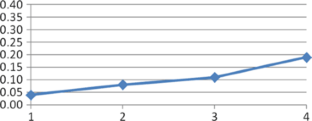Abstract
Nowadays various researches have been conducted on the utilization of Friend-Of-A-Friend (FOAF) as the foundation of social network services. However, automatic update and dynamic management of FOAF for the social network services are difficult. Hereupon, we propose a novel method to overcome the above problems by applying FOAF and RDF Site Summary (RSS) to OnLine Analytical Processing (OLAP) system. The proposed method generates the OLAP cube by using the collected FOAF and RSS from the web, and then processes the generated OLAP cubes. The implemented result shows that foaf:interest of users has reached an average of 19 % increase in 4 weeks. In proportion to the increased foaf:interest change, the number of foaf:knows of users has grown to an average of 9 %. By using the suggested method, we can provide better services in coping up with the rapid change of user interests with the automatic application of FOAF.








References
Barabasi AL, Jeong H, Neda Z et al (2002) Evolution of the social network of scientific collaborations. Phys A, Stat Mech Appl 311(3–4):590–614
Li T, Yu F, Lin Y et al (2011) Trusted computing dynamic attestation using a static analysis based behaviour model. J Converg 2(1):61–68
Gonzalez JL, Marcelnez R (2011) Phoenix: fault-tolerant distributed web storage based on URLs. J Converg 2(1):79–86
Breslin J, Decker S (2007) The future of social networks on the Internet—the need for semantics. IEEE Internet Comput 11(6):86–90
Teraoka T (2012) Organization and exploration of heterogeneous personal data collected in daily life. Hum-centric Comput Inf Sci 2(1):1–15
FOAF project. http://www.foaf-project.org
Dumbill E (2002) Finding friends with XML and RDF. XML watch
Brickley D, Miller L (2003) FOAF vocabulary specification. Technical report
Herring SC, Scheidt LA, Bonus S et al (2004) Bridging the gap: a genre analysis of weblogs. In: Proc of the 37th annual Hawaii international conference, p 11
Mika P (2005) Flink: semantic web technology for the extraction and analysis of social networks. J Web Semant 3(2–3):211–223
Matsuo Y, Mori J, Hamasaki M et al (2007) POLYPHONET: an advanced social network extraction system from the web. J Web Semant 5(4):262–278
Culotta A, Bekkerman R, McCallum A (2004) Extracting social networks and contact information from email and the web
Paolillo JC, Mercure S, Wright E (2005) The social semantics of LiveJournal FOAF: structure and change from 2004 to 2005. In: Proc ISWC 2005, pp 69–80
RSS Specifications. http://www.rssboard.org/rss-specification
Gruhl D, Meredith DN, Pieper JH et al (2006) The web beyond popularity: a really simple system for web scale RSS. In: Proc 15th international conference on World Wide Web, pp 183–192
Golbeck J, Rothstein M (2008) Linking social networks on the web with foaf: a semantic web case study. In: Proc of the twenty-third AAAI conference on artificial intelligence, pp 1138–1143
Livejournal. http://livejournal.com
Facebook. http://facebook.com
Jukic N, Jukic B, Malliaris M (2008) Online analytical processing (OLAP) for decision support. In: Handbook on decision support systems 1, pp 259–276
Chaudhuri S, Dayal U (1997) An overview of data warehousing and OLAP technology. SIGMOD Rec 26(1):65–74
Inmon WH (2005) Building the data warehouse. Wiley, New York
Kumar R, Novak J, Tomkins A (2010) Structure and evolution of online social networks. In: Link mining: models, algorithms, and applications, pp 337–357
Aikebaier A, Enokido T, Takizawa M (2011) Trustworthy group making algorithm in distributed systems. Hum-centric Comput Inf Sci 1(6):1–15
Zhou L, Ding L, Finin T (2011) How is the semantic web evolving? A dynamic social network perspective. Comput Hum Behav 27(4):1294–1302
Yeung C, Liccardi I, Lu K et al (2009) Decentralization: the future of online social networking. School of Electronics and Computer Science, University of Southampton
Jung J, Euzenat J (2007) Towards semantic social networks. In: The semantic web: research and applications, pp 267–280
Mika P (2005) Social networks and the semantic web: the next challenge. IEEE Intell Syst 20(1):82–85
Mika P (2005) Ontologies are us: a unified model of social networks and semantics. In: Proc the semantic web—ISWC 2005, pp 522–536
Finin T, Ding L, Zhou L et al (2005) Social networking on the semantic web. Learn Organ 12(5):418–435
Szomszor M, Alani H, Cantador I et al (2008) Semantic modelling of user interests based on cross-folksonomy analysis. In: Proc the semantic web—ISWC 2008, pp 632–648
Chakrabarti S, Joshi MM, Punera K et al (2010) The structure of broad topics on the web, pp 251–262
Duong TH, Nguyen NT, Jo GS (2010) Constructing and mining a semantic-based academic social network. J Intell Fuzzy Syst 21(3):197–207
Jiawei H, Yongjian F, Wei W et al (1996) DMQL: a data mining query language for relational databases. In: SIGMOD96’ workshops on research issues in data mining and knowledge discovery
FOAF me. http://foaf.me/index.php
Bortoli S, Stoermer H, Bouquet P et al (2007) Foaf-o-matic-solving the identity problem in the foaf network. In: Proc semantic web applications and perspectives (SWAP 2007), pp 130
Kruk SR (2004) FOAF-realm-control your friends’ access to the resource. In: Proc FOAF workshop
Author information
Authors and Affiliations
Corresponding author
Rights and permissions
About this article
Cite this article
Sohn, JS., Chung, IJ. Dynamic FOAF management method for social networks in the social web environment. J Supercomput 66, 633–648 (2013). https://doi.org/10.1007/s11227-012-0847-x
Published:
Issue Date:
DOI: https://doi.org/10.1007/s11227-012-0847-x
